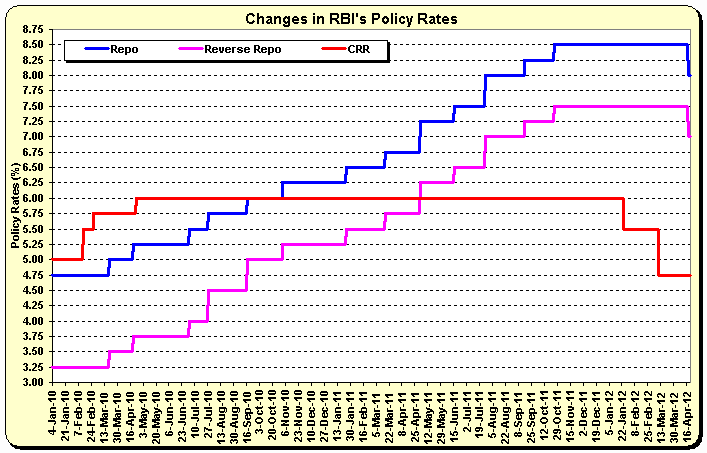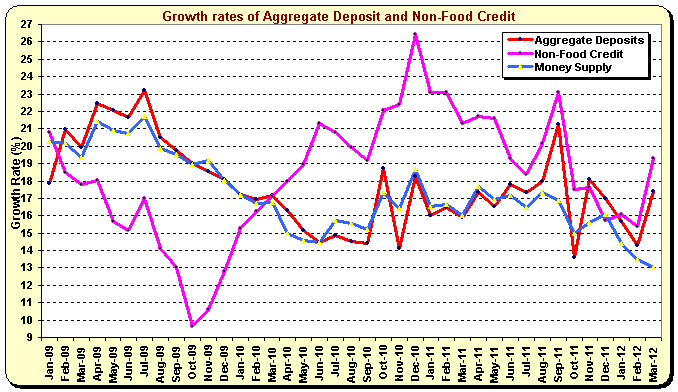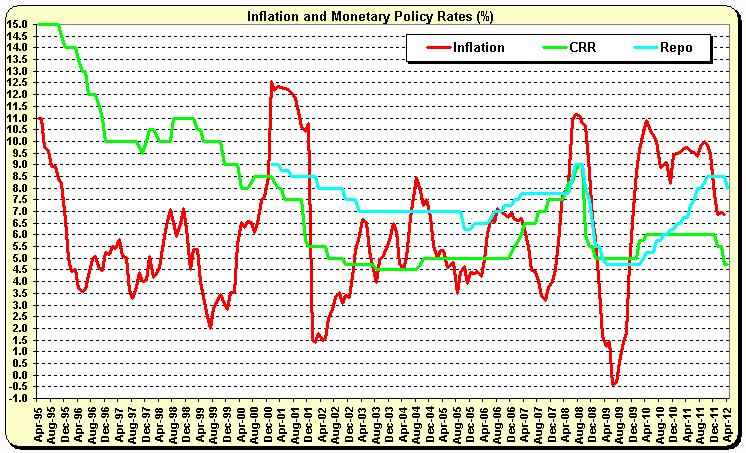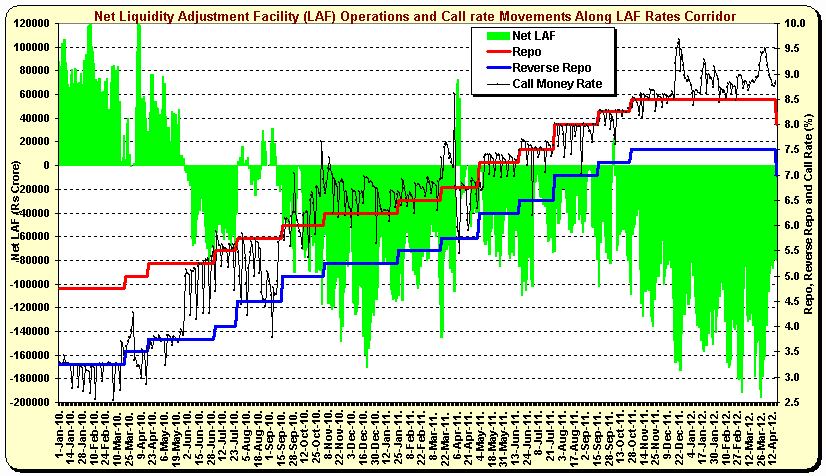|
The Reserve Bank of India (RBI) has released the Annual Monetary Policy Statement 2012-13, reducing key monetary policy rate i.e. repo rate, lending rate to banks, by 50 bps to 7.5%. The repo rate cut has been above economists expecting 25 bps cut, while it was first rate cut after three years. However, the Cash reserve Ratio has been kept unchanged at 4.75%.
RBI has projected GDP growth for 2012-13 at 7.3%. However, RBI has placed the baseline projection for inflation of March 2013 at 6.5%. Meanwhile, it expects the broad money supply (M3) to grow 15% during 2012-13. The banks aggregate deposit growth and non-food credit growth is placed at 16.0% and 17.0%, respectively for 2012-13.

Considerations behind the Policy Move
Growth decelerated significantly to 6.1% in Q3FY2012, while the economy is clearly operating below its post-crisis trend.
Headline WPI inflation moderated significantly to below 7% by March 2012. More importantly, non-food manufactured products inflation has dropped to 4.7% in March 2012, actually coming below 5% for the first time in two years.
Monetary Policy Stance
Adjust the policy rates to levels consistent with the current growth moderation;
Guard against risks of demand-led inflationary pressures re-emerging; and
Provide greater liquidity cushion to the financial system.
Guidance
Deviation of growth from its trend is modest, while upside risks to inflation persist. These considerations inherently limit the space for further reduction in policy rates.
Moreover, if subsidies are not contained as indicated in the Union Budget last month, demand pressures will persist, and will further reduce whatever space there is for monetary easing.
Liquidity conditions have eased in recent weeks, while the latest increase in the MSF limit to banks should provide additional liquidity comfort. However, appropriate and proactive steps will be taken with the objective of restoring comfort zone conditions.
| Annual Monetary Policy 2011-12 Projections of Various Indicators |
| Policy Review on |
3-May-11 |
26-Jul-11 |
25-Oct-11 |
24-Jan-12 |
Actual |
| GDP |
8%* |
8%* |
7.6 |
7.0 |
6.9 |
| March 2012 Inflation |
6%$ |
7 |
7.0 |
7.0 |
6.9 |
| Money Supply (M3) |
16 |
15.5 |
15.5 |
15.5 |
13 |
| Aggregate Deposits |
17 |
17 |
17 |
17 |
17.4 |
| Non-Food Credit |
19 |
18 |
18 |
16 |
19.3 |
| Repo Rate |
7.25 |
8 |
8.5 |
8.5 |
8.5 |
| Reverse Repo Rate |
6.25 |
7 |
7.5 |
7.5 |
7.5 |
| * around, $ with upward bias |
| Annual Monetary Policy Projections of Various Indicators for 2012-13 |
| Policy Review on |
17-Apr-12 |
| GDP |
7.3 |
| March 2012 Inflation |
6.5 |
| Money Supply (M3) |
15.0 |
| Aggregate Deposits |
16.0 |
| Non-Food Credit |
17.0 |
| Repo Rate |
8.0 |
| Reverse Repo Rate |
7.0 |
Expected Outcomes
Growth will stabilize around its current post-crisis trend.
Risks of inflation and inflation expectations re-surging will be contained.
Liquidity cushion available to the system will be enhanced.
Global Economy
Sustainable solution to the euro area debt problem is yet to emerge. Recent developments, for example in Spain, indicate that the euro area sovereign debt problem will continue to weigh on the global economy.
Growth also slowed down in emerging and developing economies (EDEs)
International crude oil prices have risen by about 10% since January and show signs of persisting at current levels.
Indian Economy
Economic growth decelerated in 2011-12, mainly due to deceleration in industrial growth. Growth in the services sector held up relatively well. On the demand side, gross fixed capital formation contracted both in the second and third quarters of last year.
Overall growth outlook for 2012-13 looks a little better than it was last year. Accordingly, the Reserve Bank's baseline projection of GDP growth for the current year is 7.3%.
Inflation
Food articles inflation continues to be high. Significantly, inflation in protein items is in double digits, reflecting persistent structural demand-supply imbalances in protein foods.
Fuel inflation moderated to 10.4 % in March 2012 even as global crude oil prices rose sharply, reflecting the absence of a commensurate pass-through to domestic consumers.
Non-food manufactured products inflation decelerated significantly to 4.7% in March 2012, on the back of a slowdown in domestic demand and softening of global non-oil commodity prices.
New series of consumer price index (CPI) suggests that price pressures are still high at the retail level.
The Reserve Bank's projection of inflation for March 2013 is 6.5%.
Monetary and Liquidity Conditions
Consistent with growth and inflation projections, M3 growth for 2012-13 is projected at 15%.
Aggregate deposits of scheduled commercial banks are projected to grow by 16%
Keeping in view the need to balance the resource requirements of the private sector and the public sector, growth in non-food credit of scheduled commercial banks (SCBs) is projected at 17%.

Risk Factors
Although upside risks to oil prices from the demand side are limited, geo-political tensions are a concern. Any disruption in supplies is likely to lead to further increase in crude oil prices.
Even though the Budget has proposed a reduction in the fiscal deficit in the current year, there are several upside risks. Any slippage in the fiscal deficit will have implications for inflation.
Large Government borrowing budgeted for 2012-13 has the potential to crowd out credit to the private sector. If that happens, the supply response required to accelerate growth could be inhibited.
Financing of the current account deficit will continue to pose a major challenge.
Structural imbalances in protein-rich foods persist, and consequently, food inflation is likely to remain under pressure.
Developmental and Regulatory Policies
Financial inclusion
It is proposed to mandate state level bankers' committees (SLBCs) to prepare roadmaps covering all unbanked villages of population of less than 2000, and notionally allot these villages to banks for providing banking services in a time bound manner.
Three measures on customer service in banks
1. banks are being advised to offer a ‘basic savings bank deposit account' with certain minimum common facilities and without the requirement of a minimum balance to all their customers.
2. banks will be mandated not to levy foreclosure charges or pre-payment penalties on home loans extended on a floating interest rate basis.
3. banks are being advised to initiate steps to allot a unique customer identification code (UCIC) number to all their customers.
Banking Regulation and supervision
On Basel III, final guidelines on the implementation of capital regulations will be issued by end-April 2012, and final guidelines on liquidity risk management and liquidity standards by end-May 2012.
Non-performing assets of banks have increased in the recent period. We are mandating banks to put in place a robust mechanism for early detection of signs of distress and take remedial measures.
Final guidelines on securitization will be issued by end-April 2012.
NBFCs
There has been a significant increase in loans against gold by non-banking financial companies in the recent period, which has raised several concerns. This policy contains three measures to regulate this further:
1. Banks should reduce their regulatory exposure ceiling to a single NBFC, having gold loans to the extent of 50% or more of its total financial assets, from the existing 10% to 7.5% of bank's capital funds.
2. Banks should have an internal sub-limit on their aggregate exposure to all such NBFCs, having gold loans to the extent of 50% or more of their total financial assets, taken together.
3. Reserve Bank has constituted a Working Group to undertake a detailed study of gold demand, trends in gold prices and lending by NBFCs against gold.
Measures relating to NBFCs
Draft guidelines on overseas investment by core investment companies (CICs) will be placed on the Reserve Bank's website for public comments by end-April 2012.
It has been decided to issue the draft guidelines on the regulatory framework for NBFCs by end-June 2012 based on the recommendations of the Usha Thorat Working Group.
Currency management
With a view to address the issue of counterfeit notes in circulation, banks are advised to ensure that notes received over the counters are re-circulated only after ensuring their proper authentication through machines.
Keeping in view the extended geographical spread of bank branch network and leveraging on technology, we have decided to channelize the distribution of currency and coins only through currency chests and bank branches.
Expert Views
Sonal Varma, India Economist, Nomura Financial Advisory Services
In our view, the ambiguity on potential future actions is due to inflation risks. The RBI projects wholesale price index (WPI) inflation at 6.5% by March 2013, in line with our estimates, but highlighted that upside risks remain due to high oil prices, suppressed inflation, fiscal slippage and rupee depreciation. Meanwhile, the RBI believes that leading indicators suggest a turnaround in industrial output growth, in line with our view. Accordingly, it expects real GDP growth to improve moderately to 7.3% y-o-y (Nomura: 7.4%) in FY13 (year ending March 2013) from our estimated FY12 GDP growth of 6.8%. To a large extent, the RBI has front-loaded its rate cuts, which is prudent given the lags in policy transmission. Any future rate cuts will hinge on whether core inflation remains low and growth remains below trend. With the next scheduled meeting on 18 June, the April/May WPI inflation reading will take precedence. We expect both headline and core inflation to inch higher in April due to the hike in indirect taxes and adverse base effects. As such, we expect the RBI to remain on hold in June and most likely in July as well. Thereafter, the RBI will continue to face the challenge of sticky headline inflation due to rising food and fuel prices (assuming administered fuel prices are hiked), but a fall in core inflation from lower non-oil commodity prices and the lagged effect of a negative output gap. On balance, we expect only one more repo rate cut of 25bp in 2012.
Taimur Baig, Chief Economist, Deutsche Bank
Our forecasts suggest that inflation will be well below 6.5% in April, but head up from May onward and will go above 7% if fuel prices are increased in midyear. Hence from the angle of inflation momentum and the need to assess pass-through risks, the RBI will have a rather tight window to ease policy. Our thinking is the following: if growth remains particularly weak (Jan-March GDP data will be available in time for the next policy meeting) and the government makes progress toward fiscal consolidation (by announcing fuel price adjustment), then the RBI will cut the policy rate by 25bps on June 18. We assign this outcome a 55% probability. If neither happens, it should be months before the central bank moves again, perhaps as late as the final quarter of the calendar year.
Indranil Pan, Chief Economist, Kotak Mahindra Bank
We think that the RBI could cut rates again though the timing and the extent will be a bit unsure given the front-loading of repo rate cuts on Tuesday. It would probably require the RBI to factor in more incremental data to decide on its next move. Hence, we think that the RBI could act again sometime in 2HFY13. By this time, the dynamics of the monsoon and its implication for domestic growth/inflation would also have been ascertained. Further, the RBI also gets some breathing space to factor in the risks emerging to the domestic economy from the global sources, especially through the currency dynamics and its implication for inflation. Any change in sentiment from the domestic policy side on the investment cycle would also have been ascertained. However, any further rate action would be calibrated unless warranted by extreme risk aversion globally. On the liquidity front, we continue to factor in CRR cut of 100 bps through FY2013, if the M3 target of 14.5-15.0% needs to be met. However, such CRR easing is likely to be closely associated with FX sales by the RBI to contain INR depreciation pressures.
Sujan Hajra, Chief Economist, Anand Rathi Financial Services
Drought in three key southern/western states and unseasonal rainfall in north India has worsened the outlook for the rabi crop. We expect double-digit food inflation in FY13. The hike in rail freight, indirect tax rates, likely rise in administered fuel prices, and the depreciating rupee are likely to further raise inflation. Overall, we expect WPI inflation at ~8% for most of FY13. We expect core inflation to inch up from Apr '12. Hence, it will be difficult for the RBI to cut the repo rate in a scenario of rising inflation. With today's 50bps cut, we expect the RBI to pause for the rest of the year. The RBI is likely to focus on liquidity easing in FY13 via open-market operations (`2trn) and aggressive CRR cuts (100-150bps).
Rohini Malkani, Economist, Citigroup India
Taking into account the above and our FY13 expectations for growth and inflation at 7% and 7.4%, we could see at best one more rate easing later this year. However this will be data/event-dependent, with key variables to watch being (a) measures to meet the subsidy cap of 2%, (b) pass-through of oil prices, and (c) growth and inflation outturns. Upcoming policy reviews are on June 18 and July 31. The higher-than-expected rate cut resulted in the 10y benchmark bond yield 10bps lower on the day at 8.35%. Today's rate cut, coupled with moral suasion, could result in banks lowering their lending rates.
Siddhartha Sanyal, India Economist, Barclays Capital
In our view, the RBI's guidance suggests that it has merged a couple of "baby steps" into today's move and will possibly stay on hold for awhile. We believe the central bank will examine the scope for further monetary easing on a case-by-case basis in the coming months, with a bias towards not cutting the repo rate further in the next one to two policy meetings. It was, however, proactive in containing market expectations by mentioning limited headroom for further rate cuts, particularly given the larger-than-expected rate cut, in our view. Further communication from the RBI scheduled over the next couple of days will be important to gauge its future course of action. At this stage, we remain comfortable maintaining our base case expectation of a cumulative 100-125bp of rate cuts during FY 12-13.
Leif Lybecker Eskesen, Chief Economist for India & ASEAN, HSBC
The RBI was clearly itchier to cut policy rates than expected, but the 50bp cut may have been a bit too premature and aggressive, in our view. If that turns out to be the case, it could hurt RBI's credibility while doing little to raise growth on a sustained basis. It is also difficult to reconcile the aggressive move with the fact that fundamentals have not really changed materially since the last monetary policy meeting in March.
In fact, global and domestic economic conditions remain broadly the same, in our view, while inflation risks have actually increased on the back of still high oil prices and the depreciation of the exchange rate. Yes, the budget has been delivered, but the planned tightening is not sufficient in itself to change the course of monetary policy, especially when you consider the likely fiscal slippage. However, we agree that there is limited room to cut rates further, especially following the aggressive cut today which may have added to inflation risks. There is likely only room for another 25bps in policy rate cuts, assuming that the upside risks to inflation do not materialize.
In addition, the RBI will, in our view, continue to manage liquidity conditions actively through open market operations. The liquidity deficit has, however, eased significantly due to seasonal factors and the liquidity enhancing steps taken so far. As such, additional measures may not be needed in the near term.
Abheek Barua, Chief Economist, HDFC Bank
We anticipate another 50 bps of repo rate cuts over the course of FY13 taking total repo rate cuts for the year to a relatively modest 100 bps. The central bank expects money supply to grow at 15.0% in FY13 against 13.0% at present while deposit growth is forecasted to grow at 16.0% against 13.4% for the fortnight ending 23 March 2012. This however seems unfeasible without further easing by the central bank, something it is open to doing should the pressure on liquidity to resurface. We therefore expect CRR cuts of 50 bps over the course of FY13 and anticipate that OMO buybacks of at least Rs 100000 crore may be required perhaps earlier than initial expectations of August-September 2012.
The full impact is unlikely to be felt in a hurry with credit-deposit ratio still ruling at a relatively high 76-78%. Deposit and lending rate cuts of close to 25 bps are likely only by the end of Q1FY13 as some moderation in credit demand in the slack season eases the pressure on the system.
Anubhuti Sahay, Economist, Standard Chartered Bank
In our view, the larger-than-expected repo rate cut was probably driven by two factors. First, the RBI needs to balance growth and inflation requirements. Given the positive output gap, growth clearly needs supportive polices. However, with inflation still hovering at c.7% and expected to move higher in the next few months, the RBI has a limited window of opportunity to support growth. Indeed, the RBI is non-committal on further easing, as it sees upside risks to its inflation forecast of 6.5% for March 2013. Secondly, a 50bps repo rate cut is likely to ensure better transmission of monetary policy, which is necessary to nurture a growth revival. With this statement, we highlight a risk to our call of further rate cuts by the RBI. We had expected 75bps of repo rate reductions in FY13 (began 1 April 2012).
Anjali Verma, Economist, MF Global India Securities
With today's rate cut of 50bps and indicative pause by the RBI, economic fundamentals are expected to remain stable to weak. Investment and consumption growth may persist at the current levels to lower, and thus, there are limited triggers for the asset prices to rise from these levels. Onus then shifts to the government, in terms of execution of developmental expenditure and reforms, which so far has been very disappointing. Thus, we maintain our stance that higher interest rates and 7%-7.5% economic growth levels are here to stay for a long period of time.
Naresh Takkar, MD & CEO, ICRA
The RBI's move to reduce the Repo rate by a higher-than-expected 50 basis points is likely aimed at shrinking the time lag with which Banks reduce their lending rates, in order to provide an early boost to investment and consumption sentiment. Based on the hawkish guidance provided by the RBI that the space for further reduction in policy rates is limited and the upside risks to inflation, we expect further Repo rate and CRR cuts to be restricted to 25 bps each in FY13. The increase in the limits under the Marginal Standing Facility would also improve the liquidity situation. Nevertheless, the magnitude of the Central Government's borrowing programme suggests that substantial open market bond purchases would be necessary for credit growth to expand in line with the 17% projected by the RBI. The markets eagerly await the final guidelines on implementation of Basel III and Securitisation expected by end-April 2012.
Outlook
RBI has aggressively slashed repo rate by 50 bps to 8.0%, effective from 17th April 2012. To improve the liquidity amidst huge government borrowing program, RBI has increased the borrowing limit of scheduled commercial banks under the marginal standing facility (MSF) from 1% to 2% of their net demand and time liabilities (NDTL). While the former will formally usher in lower interest rate regime, the latter can improve liquidity.
Though inflation has moderated in recent months, RBI expects it to remain sticky and above the tolerance level, even as growth has slowed. These trends are occurring in a situation in which concerns over the fiscal deficit, the current account deficit and deteriorating asset quality loom large. The challenge for monetary policy will thus be to maintain its vigil on controlling inflation while being sensitive to risks to growth and other vulnerabilities.
Banks may not be in a hurry to cut either deposit or lending rates, and may see how the liquidity and demand pan out, before taking a call. So, after a very long time, we can see some lag effect in transmission of monetary policy into interest rates on deposits as well as advances by Banks.


| Monetary Policy Stance |
|
April 2012. |
January 2012. |
October 2011. |
July 2011. |
May 2011. |
|
Adjust the policy rates to levels consistent with the current growth moderation;
Guard against risks of demand-led inflationary pressures re-emerging; and
Provide greater liquidity cushion to the financial system. |
Maintain an interest rate environment to contain inflation and anchor inflation expectations;
Manage liquidity to ensure that it remains in moderate deficit, consistent with effective monetary transmission;
Respond to increasing downside risks to growth. |
Maintain an interest rate environment to contain inflation and anchor inflation expectations.
Stimulate investment activity to support raising the trend growth.
Manage liquidity to ensure that it remains in moderate deficit, consistent with effective monetary transmission |
Maintain an interest rate environment that moderates inflation and anchors inflation expectations;
Manage the risk of growth falling significantly below trend;
Manage liquidity to ensure that monetary transmission remains effective, without exerting undue stress on the financial system. |
Anchor inflationary expectations.
Foster an environment of price stability that is conducive to sustaining growth in the medium-term, coupled with financial stability. |
|